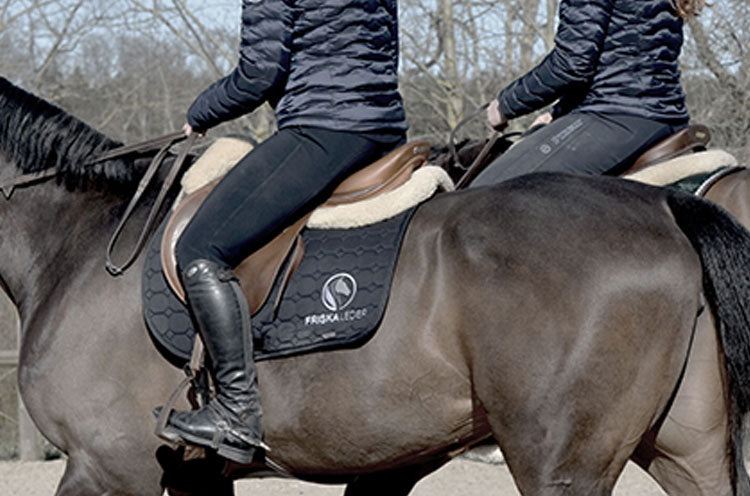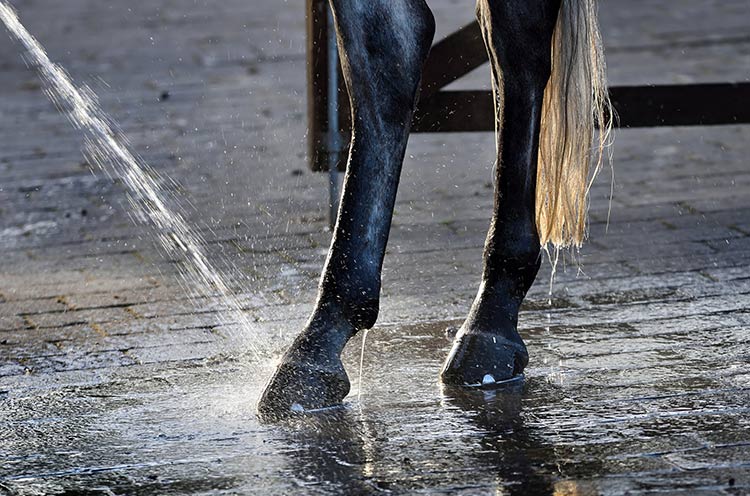How do you know whether to choose active rest or complete rest? It is not always easy to know, as it is very dependent on the horse and its conditions. All horses need some form of rest to recover both physically and mentally, especially young horses. To avoid injuries that can occur due to excess energy, it is important to find a solution that suits your horse. We at Friska Leder will help you arrive at this below.
What does complete rest mean?
Full rest means that the horse only walks in the paddock, possibly also in a walker depending on the circumstances, and then only tinkered with. Take the time to brush the horse with all the brushes in the rum box, stretch or snuggle with them. Take the opportunity to do all the things you don't really have time for in everyday life with your horse. Scratch them at that point at the withers until it actually stops itching. You can also take your horse for a walk, both to get it moving and to socialize.
What does active rest mean?
Active rest, where the horse mainly rests physically from riding, can include walking, walking machine, lunging, light emptying or other low-intensity work done. Low-intensity work done up can be working your horse in walk and even trot. For example, you can walk through the entire dressage program or lay out a course with barriers on the ground you will walk over. Trotting the horse long and low is also a great way to stretch the body. Working the horse in this way is good if it is easily stressed by rest and handles excess energy poorly. A stressed horse with too much energy can injure itself and pick up bad behavior. This type of horse rarely requires hard work to gain peace of mind, but is mostly activated and allowed to think.
Choice of rest
So how should you choose between active rest or full rest? Here we point out a few things to keep in mind:
The horse's behavior and body
Behavior
How does the horse handle rest? Does your horse get stressed and so excited that it risks injuring itself? Or does it take it easy and seems to think it's nice? The first thing you look at is how the horse reacts to being completely at rest. If you have a new horse that you don't know very well, you simply have to test yourself and be sensitive to any stressed behavior. There is a difference in the way the horses run in the pasture, for example. If the ears are pointed, your horse bucks and gallops with a neutral neck position, it is usually happy to run. If you notice that the horse is galloping tensely, pulling its rump under itself and running away from something with a high tense neck and flapping ears, this may be a sign of stress. You also often notice when you bring the horse in if it feels like it is trying to run away from something or if it is just happy.
Body
How does the horse's body react to rest? Does he get swollen legs or poor stomach function? Some horses, especially middle-aged to slightly older horses, can have physical problems from resting. For example, they may experience swollen legs, upset stomach and/or stiffness. Horses are made to be in constant motion and therefore their bodies may find it difficult to process certain things in a still state. These horses should be walked at least 20 minutes daily, preferably twice a day if possible, to avoid serious problems.
Rest length
How long should the horse rest? If it is about 3-4 days, most horses can get complete rest. If it is a horse that is to rest for 1 month, it may happen that it needs an active rest as the rest period is relatively long. A tip here might be to wind down the first week with riding every other day, low-intensity interspersed with other low-intensity work. Then the horse can perhaps have two weeks of complete rest and then in the same way as it was stepped down, it is stepped up in the last week.
Type of paddocks
What kind of access to paddocks do you have? If you have large, nice paddocks where the horse has the opportunity to move to a greater extent, complete rest can be an option. In larger paddocks, the horse naturally moves more on its own and can then have an outlet for its energy. On the other hand, if you have smaller paddocks or paddocks with poor ground, there is a risk that the horse will become very sedentary and then an active rest may be a better option.
Conditions and riding opportunities
What kind of conditions do you have to activate the horse in a simple way? Do you only have riding opportunities outside? This can then be affected by the weather and the surface. If, for example, the riding track is frozen solid and the nearest stable is some distance away, your only option may be to let your horse rest completely. If you have good bridleways out in the forest or similar, it is a great place to give your horse an active rest. Again, the question comes, what are your conditions? Is your horse nice to ride out? Do you work all day so you can only ride when it's dark? Conditions like these can put a damper on those with horses that take a full rest poorly. Then, as much as possible, try to go to the riding house at least a few days a week, so the horse can run off some energy.
Tips if you choose complete rest
If you give your horse supplements from Friska Leder and are going to give it complete rest, you can halve the dosage of the product you give. This as the horse's joints are not exposed to the same stress during complete rest. However, some horses can get galls in their legs from standing still a lot, which impairs blood circulation. Then it may be an advantage to continue giving the full dose of your Friska Leder product to optimize recovery of the joints.
Chondrogen 100Pro is a good supportive product during rest. This is because it contains several components that promote the production of synovial fluid and the supply of nutrients to the cartilage.
Tips regardless of which rest you choose
The choice between active rest and complete rest can therefore feel difficult, the most important thing is that you listen to your horse and its needs. Here are some tips to take with you into rest, regardless of the type you choose:
- Remove all concentrates that provide energy. You can either gradually taper it off the week before your horse goes to rest or slowly acclimate your horse to a low energy feed.
- Do exercises in the stall and/or box. You can stretch the horse with various exercises and also work on communication with the help of exercises in the stable aisle.
- Take out the dentist for the horse, vaccinate, vet check and/or take out, for example, the equine therapist. You can read more about this in the report Take care of your horse .




Leave a comment
This site is protected by hCaptcha and the hCaptcha Privacy Policy and Terms of Service apply.